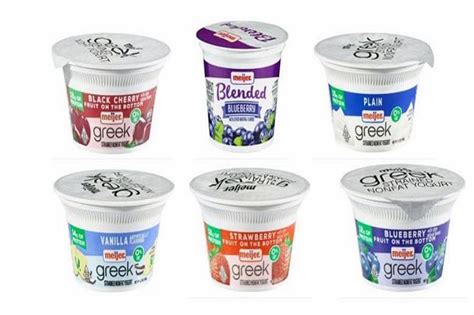
Millions of yogurt lovers are urged to inspect their refrigerators immediately following a massive product recall initiated by Lyons Magnus due to potential contamination with Cronobacter sakazakii and, in some products, Clostridium botulinum. The recall spans numerous brands and products, including popular yogurt options like Oatly, Aloha Organic Plant-Based Protein Drink, and Stumptown Cold Brew Coffee, affecting consumers nationwide.
Lyons Magnus announced the voluntary recall, emphasizing that while Cronobacter sakazakii is commonly found in the environment, it can be particularly dangerous for vulnerable populations. Although no illnesses related to the recalled products have been reported to date, the company is taking precautionary measures to prevent any potential health risks. The Food and Drug Administration (FDA) is actively monitoring the situation and providing updates to the public.
Extensive Yogurt Recall: What You Need to Know
The recall, which was initially announced in late July, has now expanded to include a wider range of products and expiration dates. Consumers are advised to check the lot codes and best-by dates printed on the packaging of their yogurt products to determine if they are affected. A comprehensive list of recalled products, along with their corresponding lot codes and expiration dates, is available on the FDA’s website and the Lyons Magnus website.
“We are committed to ensuring the safety and quality of our products,” said a spokesperson for Lyons Magnus in a press release. “We are working closely with the FDA to investigate this matter thoroughly and take all necessary steps to protect our consumers.”
The recall encompasses both dairy and non-dairy yogurt products, reflecting the widespread use of Lyons Magnus as a manufacturing partner for various brands. This has resulted in a ripple effect across the yogurt market, impacting consumers who purchase products from different retailers and under different brand names.
Understanding the Risks: Cronobacter sakazakii and Clostridium botulinum
The primary concern driving the yogurt recall is the potential contamination with Cronobacter sakazakii, a bacterium that can cause severe infections, particularly in infants, the elderly, and individuals with weakened immune systems. While infections are rare, they can be life-threatening. Symptoms of Cronobacter infection may include fever, vomiting, and urinary tract infection.
In infants, Cronobacter infections can lead to necrotizing enterocolitis (NEC), a serious intestinal disease, or meningitis, an inflammation of the membranes surrounding the brain and spinal cord. The FDA advises parents and caregivers to be particularly vigilant and to seek medical attention immediately if they suspect their child may have consumed a recalled product and is exhibiting symptoms of infection.
The presence of Clostridium botulinum is another serious concern. This bacterium can produce botulinum toxin, a potent neurotoxin that can cause botulism, a rare but potentially fatal paralytic illness. Symptoms of botulism can include double vision, blurred vision, drooping eyelids, slurred speech, difficulty swallowing, muscle weakness, and paralysis. Botulism requires immediate medical attention.
“Botulism is a medical emergency and can result in death if not treated promptly,” warned the FDA in its recall announcement. “Consumers who experience any of these symptoms should seek immediate medical attention.”
Impact on Consumers and Retailers
The yogurt recall has caused widespread disruption for both consumers and retailers. Consumers are faced with the inconvenience of having to check their refrigerators for recalled products and discard them. Many are also experiencing anxiety about potential health risks, particularly if they have already consumed the affected yogurt.
Retailers, including major grocery chains and convenience stores, have been tasked with removing recalled products from their shelves and informing customers about the recall. This process can be logistically challenging, especially for retailers with large inventories and multiple locations. The recall has also led to financial losses for retailers due to the removal of unsaleable products and the potential for decreased consumer confidence.
Lyons Magnus’ Response and Investigation
Lyons Magnus is cooperating fully with the FDA in its investigation of the contamination. The company is working to identify the source of the contamination and implement corrective measures to prevent future occurrences. The company has also established a consumer hotline to answer questions and provide guidance to consumers who have purchased recalled products.
“We are taking this matter very seriously and are committed to providing our customers with safe, high-quality products,” said the Lyons Magnus spokesperson. “We are working diligently to resolve this issue as quickly as possible.”
The FDA is conducting its own investigation to determine the root cause of the contamination and to assess the effectiveness of Lyons Magnus’ corrective actions. The agency is also working to ensure that all recalled products are removed from the market and that consumers are adequately informed about the recall.
How to Identify Recalled Products
Consumers can identify recalled products by checking the following information on the packaging:
- Brand Name: Check if the product is one of the brands listed in the recall announcement. These brands include Oatly, Aloha Organic Plant-Based Protein Drink, Stumptown Cold Brew Coffee, and many others. A comprehensive list is available on the FDA’s website.
- Product Name: Verify that the specific product name matches the list of recalled products.
- Lot Code: Locate the lot code printed on the packaging. This code is typically a series of numbers and letters that identify the specific batch of product. Compare the lot code to the list of recalled lot codes provided by Lyons Magnus and the FDA.
- Best-By Date: Check the best-by date printed on the packaging. Only products with best-by dates that fall within the specified range are subject to the recall.
Consumers who have purchased recalled products should not consume them. They should discard the products immediately or return them to the place of purchase for a refund.
Long-Term Implications for the Yogurt Industry
The yogurt recall has raised concerns about the safety and quality control measures in the yogurt industry. It has also highlighted the potential risks associated with using contract manufacturers, as Lyons Magnus produces yogurt for a variety of different brands.
The incident is likely to lead to increased scrutiny of manufacturing processes and more stringent testing requirements for yogurt products. Consumers may also become more cautious about their yogurt purchases and more likely to check for recalls and safety information.
The long-term impact of the recall on consumer confidence in the yogurt industry remains to be seen. However, it is clear that the industry will need to take steps to restore trust and ensure the safety of its products. This may include investing in new technologies, improving quality control procedures, and enhancing transparency with consumers.
The recall serves as a reminder of the importance of food safety and the potential consequences of contamination. It also underscores the need for companies to have robust systems in place to prevent and detect contamination, and to respond quickly and effectively when a recall is necessary. The FDA plays a crucial role in overseeing the food industry and protecting public health, and its investigation of this recall will be critical in identifying the root cause of the contamination and preventing future incidents. Consumers should stay informed about food recalls and take necessary precautions to protect themselves and their families.
Frequently Asked Questions (FAQ)
-
What products are included in the yogurt recall?
The recall includes a wide range of yogurt products manufactured by Lyons Magnus, including brands such as Oatly, Aloha Organic Plant-Based Protein Drink, and Stumptown Cold Brew Coffee. The specific products and lot codes affected can be found on the FDA’s website (https://www.fda.gov/) and the Lyons Magnus website. The recalled products include both dairy and non-dairy options. Always check the specific product name, lot code, and best-by date against the official recall list.
-
What are the potential health risks associated with the recalled yogurt?
The recalled yogurt products may be contaminated with Cronobacter sakazakii and, in some cases, Clostridium botulinum. Cronobacter sakazakii can cause infections, particularly in infants, the elderly, and individuals with weakened immune systems. Symptoms may include fever, vomiting, and urinary tract infection. Clostridium botulinum can produce botulinum toxin, which causes botulism, a potentially fatal paralytic illness. Symptoms of botulism include double vision, blurred vision, drooping eyelids, slurred speech, difficulty swallowing, muscle weakness, and paralysis.
-
What should I do if I have purchased a recalled yogurt product?
If you have purchased a recalled yogurt product, do not consume it. Discard the product immediately or return it to the place of purchase for a full refund. Wash your hands thoroughly after handling the recalled product. If you experience any symptoms of Cronobacter infection or botulism, seek immediate medical attention.
-
How can I identify if my yogurt is part of the recall?
Check the product’s packaging for the brand name, product name, lot code, and best-by date. Compare this information to the list of recalled products provided on the FDA’s website and the Lyons Magnus website. If your product matches the recalled information, it is part of the recall.
-
Has anyone gotten sick from the recalled yogurt products?
As of the latest reports, no illnesses related to the recalled products have been reported to date. However, Lyons Magnus initiated the recall as a precautionary measure to prevent any potential health risks.
Detailed List of Recalled Brands (Excerpt – Check FDA Website for Comprehensive List):
- Oatly: Several Oatly Barista Edition products are included in the recall due to potential Cronobacter sakazakii contamination. Specific lot numbers and expiration dates are crucial for identification.
- Aloha Organic Plant-Based Protein Drink: Numerous flavors and sizes of Aloha Organic Plant-Based Protein Drinks are affected by the recall. Check individual product labels against the official recall list.
- Stumptown Cold Brew Coffee: Certain Stumptown Cold Brew Coffee products manufactured by Lyons Magnus are part of the recall. Verify lot codes and expiration dates to determine if your product is impacted.
- Lyons Barista Style Oat Milk: This is also on the recall list.
- Imperial: Check individual products.
- Premier Protein: This is also on the recall list
- Glucerna: Check individual products.
Extended Analysis of Cronobacter sakazakii and Clostridium botulinum Contamination
Cronobacter sakazakii is a gram-negative, facultative anaerobic bacterium that belongs to the Enterobacteriaceae family. It is commonly found in dry foods, such as powdered infant formula, and can survive in low-moisture environments for extended periods. While Cronobacter infections are rare, they can be particularly dangerous for infants, causing severe complications such as necrotizing enterocolitis (NEC) and meningitis.
The mechanisms by which Cronobacter causes infection are not fully understood, but it is believed that the bacteria can adhere to and invade intestinal cells, leading to inflammation and tissue damage. In infants, the immature immune system may be unable to effectively fight off the infection, increasing the risk of severe complications.
The detection of Cronobacter in food products is challenging due to its low prevalence and the lack of standardized detection methods. However, advancements in molecular techniques, such as polymerase chain reaction (PCR), have improved the sensitivity and specificity of Cronobacter detection.
Clostridium botulinum is a gram-positive, anaerobic bacterium that produces botulinum toxin, one of the most potent neurotoxins known. Botulinum toxin blocks the release of acetylcholine, a neurotransmitter that is essential for muscle function, leading to paralysis.
Botulism is a rare but potentially fatal illness that can result from consuming food contaminated with botulinum toxin. Symptoms of botulism typically appear within 12 to 36 hours after consuming contaminated food and can include double vision, blurred vision, drooping eyelids, slurred speech, difficulty swallowing, muscle weakness, and paralysis.
The risk of botulism is particularly high in improperly canned or preserved foods, as the anaerobic conditions within the can or jar provide an ideal environment for Clostridium botulinum to grow and produce toxin. However, botulism can also occur in other types of food products, such as yogurt, if they are contaminated with Clostridium botulinum and not properly refrigerated.
The treatment for botulism involves administering botulinum antitoxin, which neutralizes the toxin and prevents it from causing further damage. However, antitoxin is most effective when administered early in the course of the illness, so it is crucial to seek medical attention immediately if botulism is suspected.
The Role of the FDA in Food Safety Regulation
The Food and Drug Administration (FDA) is the primary federal agency responsible for regulating the safety of food products in the United States. The FDA’s mission is to protect public health by ensuring that foods are safe, wholesome, sanitary, and properly labeled.
The FDA has a wide range of regulatory authorities, including the power to inspect food manufacturing facilities, require food companies to implement preventive controls to minimize the risk of contamination, and recall unsafe food products from the market.
The FDA also works closely with other government agencies, such as the Centers for Disease Control and Prevention (CDC) and the U.S. Department of Agriculture (USDA), to monitor foodborne illnesses and outbreaks and to develop strategies for preventing them.
In the case of the Lyons Magnus yogurt recall, the FDA is actively investigating the contamination and working with the company to ensure that all recalled products are removed from the market and that consumers are adequately informed about the recall. The FDA is also conducting its own investigation to determine the root cause of the contamination and to assess the effectiveness of Lyons Magnus’ corrective actions.
Preventive Measures and Best Practices for Food Manufacturers
Food manufacturers have a responsibility to implement robust preventive controls to minimize the risk of contamination and ensure the safety of their products. These controls should be based on a hazard analysis and critical control points (HACCP) plan, which identifies potential hazards in the food manufacturing process and establishes critical control points (CCPs) to prevent or eliminate those hazards.
Some common preventive measures that food manufacturers can implement include:
- Good Manufacturing Practices (GMPs): GMPs are a set of basic hygiene and sanitation requirements that all food manufacturers must follow. These requirements cover a wide range of topics, including facility design, equipment maintenance, employee hygiene, and pest control.
- Supplier Verification: Food manufacturers should verify that their suppliers are also following GMPs and have implemented effective food safety controls. This can be done through audits, inspections, and testing of raw materials.
- Process Controls: Food manufacturers should implement process controls to ensure that food products are processed safely and effectively. These controls may include temperature monitoring, pH control, and time-temperature control.
- Sanitation: Food manufacturers should have a robust sanitation program to prevent contamination of food products. This program should include regular cleaning and sanitizing of equipment and facilities, as well as monitoring for the presence of pathogens.
- Testing: Food manufacturers should regularly test food products for the presence of pathogens and other contaminants. This testing should be conducted in accordance with established methods and should be performed by qualified laboratories.
- Traceability: Food manufacturers should have a traceability system that allows them to track food products from the point of origin to the point of sale. This system is essential for quickly identifying and recalling contaminated products.
- Recall Plan: Food manufacturers should have a written recall plan that outlines the steps they will take in the event of a product recall. This plan should include procedures for notifying customers, retrieving recalled products, and investigating the cause of the contamination.
Consumer Tips for Food Safety
Consumers also play an important role in ensuring food safety. Here are some tips that consumers can follow to protect themselves and their families from foodborne illnesses:
- Wash Your Hands: Wash your hands thoroughly with soap and water before and after handling food.
- Cook Food Thoroughly: Cook food to the proper internal temperature to kill harmful bacteria. Use a food thermometer to ensure that food is cooked to the correct temperature.
- Separate Raw and Cooked Foods: Keep raw meats, poultry, and seafood separate from cooked foods to prevent cross-contamination.
- Refrigerate Food Promptly: Refrigerate perishable foods within two hours of cooking or purchasing them.
- Clean and Sanitize Surfaces: Clean and sanitize countertops, cutting boards, and other surfaces that come into contact with food.
- Check for Recalls: Stay informed about food recalls and take necessary precautions if you have purchased a recalled product.
- Follow Package Instructions: Follow the instructions on food packaging for proper storage and preparation.
- When in Doubt, Throw it Out: If you are unsure whether a food is safe to eat, throw it out.
The Broader Context of Food Recalls in the United States
Food recalls are a relatively common occurrence in the United States, with hundreds of recalls occurring each year. These recalls can be triggered by a variety of factors, including contamination with pathogens, undeclared allergens, foreign objects, and mislabeling.
The increasing complexity of the food supply chain has made it more challenging to prevent and detect food contamination. Food products are often sourced from multiple countries and processed in multiple facilities before reaching consumers, increasing the risk of contamination at any point along the way.
The implementation of the Food Safety Modernization Act (FSMA) in 2011 has led to significant improvements in food safety regulation in the United States. FSMA shifts the focus from responding to foodborne illnesses to preventing them, and it gives the FDA new authorities to inspect food manufacturing facilities, require food companies to implement preventive controls, and recall unsafe food products from the market.
Despite these improvements, food recalls remain a necessary tool for protecting public health. The Lyons Magnus yogurt recall serves as a reminder of the importance of food safety and the need for continued vigilance by both food manufacturers and consumers.
Financial Implications for Lyons Magnus and Affected Brands
The yogurt recall undoubtedly carries significant financial implications for Lyons Magnus and the various brands whose products were affected. These costs can be categorized into several areas:
- Recall Expenses: The direct costs associated with the recall itself, including notifying retailers and consumers, removing recalled products from shelves, storing returned products, and ultimately destroying the contaminated yogurt. This also involves staffing call centers and managing the logistics of the reverse supply chain.
- Lost Sales: The immediate loss of revenue from the recalled products, as well as the potential for decreased sales of other products from the same brand due to consumer concerns. This impact can extend beyond the immediate recall period as consumers may switch to competing brands.
- Legal and Regulatory Costs: The expenses related to investigations by the FDA and potential lawsuits from consumers who may have been harmed by the contaminated products. This could include legal fees, settlement costs, and potential fines.
- Brand Damage: The long-term impact on brand reputation and consumer trust. A major recall can erode consumer confidence in a brand, leading to decreased sales and market share over time. Rebuilding brand trust can require significant investment in marketing and public relations.
- Supply Chain Disruptions: The recall may disrupt the supply chain for Lyons Magnus and its clients, potentially leading to increased costs and delays in production. This could require finding alternative suppliers or modifying manufacturing processes.
- Insurance Costs: Increased insurance premiums as a result of the recall. Food manufacturers typically carry product liability insurance to cover the costs associated with recalls and potential lawsuits.
The exact financial impact of the yogurt recall will depend on the extent of the contamination, the effectiveness of the recall efforts, and the long-term impact on consumer confidence. However, it is clear that the recall will be a costly event for Lyons Magnus and the affected brands.
Conclusion
The Lyons Magnus yogurt recall is a significant event that underscores the importance of food safety and the need for vigilance throughout the food supply chain. The potential contamination with Cronobacter sakazakii and Clostridium botulinum posed a serious threat to public health, particularly for vulnerable populations.
The recall highlights the challenges of maintaining food safety in a complex and globalized food system. It also underscores the critical role of the FDA in regulating the food industry and protecting consumers.
Both food manufacturers and consumers have a responsibility to ensure food safety. Food manufacturers must implement robust preventive controls to minimize the risk of contamination, and consumers must follow safe food handling practices to protect themselves from foodborne illnesses. Staying informed about food recalls and taking necessary precautions is essential for maintaining a safe and healthy food supply. The long-term consequences of this recall will likely include increased scrutiny of manufacturing processes, more stringent testing requirements, and a renewed focus on rebuilding consumer trust within the yogurt industry.









